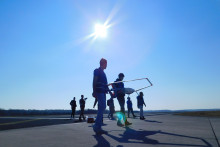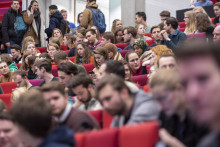The preparation for the test takes more than two hours. The team inspects every part of the drone - called Hammerhead because of its shape - carefully during the so-called scrutineering. This takes place in a Space053 room at Twenthe Airport. Team manager Sietse Oosterhout also explains why the previous test did not yield the desired result. 'The drone was leaning forward too much. The pilot couldn't get that under control, so the drone only stayed in the air for a few seconds. We made several adjustments, so I expect it to be better today.'


3D plastic
Those expectations increase during the scrutineering when the technicians find no abnormalities. In two vans, the team of ten moves to the runway. After another thorough check, in which the team goes over all the safety points, it finally seems like takeoff time. But exactly at that moment, a private jet lands at Twenthe Airport. After another half hour of patience, pilot Bryan sets the drone in motion. Hamerhead takes off at tremendous speed, but just as quickly, she falls back to earth. The 3D-printed plastic largely splashes apart. The disappointed looks from the team members speak volumes.
Later viewing of the footage should reveal what went wrong. The team members have another four months to fix the problems, because then the iMechE UAS Challenge awaits. And DroneTeam Twente travels to England full of ambition. 'We are going for a podium place. About thirty teams from all over the world are participating. Especially teams from England are good, they are considered the biggest competitors. We are the only Dutch team participating', says team member Wouter Gerritsen.


The ambition may seem high after two test deceptions, but also during the competition several teams collapsed to the ground, according to Gerritsen. If the drone remains in the air for a longer period of time, he believes a place on the podium will come close. In theory, the drone of the Twente team can reach a speed of about 120 kilometers per hour.
Different models
In 2019 DroneTeam Twente also wanted to go to England, but their drone crashed a week before the competition. In 2020 and 2021 corona put a line in the competition. 'So this year we want to impress. We believe in our chances. In the competition you see all kinds of different models, with different controls. That makes the competition interesting. For example, you're not going to see our form, with these wings,' predicts Gerritsen.
In the competition, teams must show that they can fly a payload of a certain weight somewhere as quickly as possible. A task that fits into the larger ambitions of drone development: using a drone to make a difference in developing countries, by delivering medicines and vaccines to areas that are almost impossible to reach. 'In time, our drone would also be suitable for that, but first it's back to the drawing board. After two failed tests, there is still plenty of work to be done,' concludes Gerritsen.






